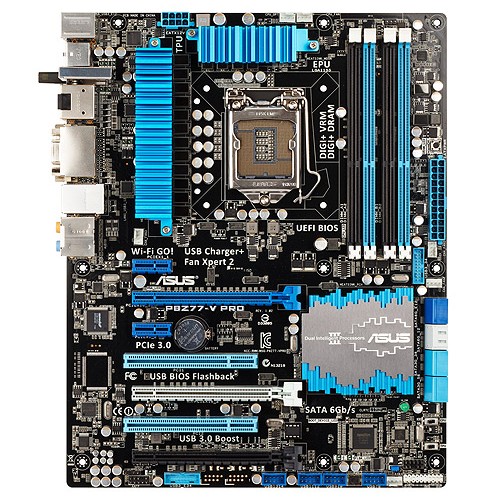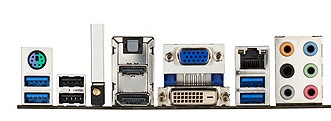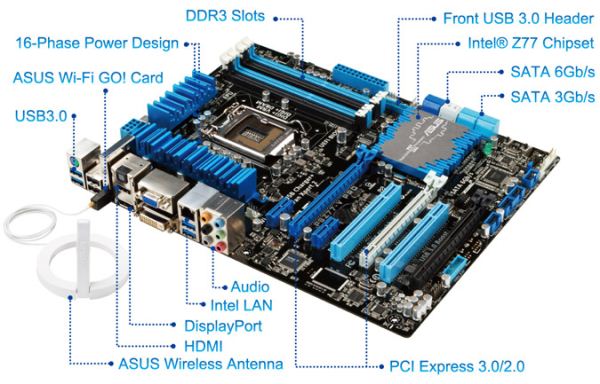Intel Z77 Panther Point Chipset and Motherboard Preview – ASRock, ASUS, Gigabyte, MSI, ECS and Biostar
by Ian Cutress on April 8, 2012 12:00 AM EST- Posted in
- Motherboards
- Intel
- Biostar
- MSI
- Gigabyte
- ASRock
- Asus
- Ivy Bridge
- ECS
- Z77
ASUS P8Z77-V Pro—Visual Inspection
ASUS have a lot to live up to with its Ivy Bridge Pro board. Both the ASUS P8P67 Pro and ASUS P8Z68-V Pro have been top class sellers in their respective chipsets, meaning that ASUS has to deliver. Thankfully, by just looking at the board, it seems that ASUS is keen to innovate and offer a complete package.
Using a 12 + 4 VRM power delivery system, the ASUS P8Z77-V Pro sports a blue and black livery synonymous with their channel / non-ROG products. The VRM heatsinks cover a lot of surface area in their jagged fashion, and around the socket itself, we have access to five main fan headers. Two of these are CPU 4-pin headers just north of the top VRM heatsink, one 4-pin below the left hand side VRM heatsink, and two 4-pin headers below the 24-pin ATX power connector, along with a USB 3.0 port. A sixth fan header (4-pin) is found on the south side of the board.

Above the 24-pin ATX power connector, we find the ASUS MemOK! button, which allows memory recovery to default speeds. Along with the ASRock boards, we have eight SATA ports—four SATA 3 Gbps from the PCH and four SATA 6 Gbps—two from the PCH and two more from an ASMedia controller. Below this are the TPU and EPU switches, designed for enhanced CPU performance and energy saving modes respectively.

Along the bottom of the board is the standard array of a front panel audio header, another USB 3.0 header, USB 2.0 headers, and a front panel header. In terms of PCIe layout, despite there being three full-length PCIe connectors on board, we are only limited to using two for multi-GPU setups. In order, we have a PCIe x1, a PCIe 3.0 x16 (x8 in dual GPU), x1, PCI, PCIe 3.0 x8, PCI, and a PCIe 2.0 x4. Thus in dual GPU mode, similarly to the ASRock Extreme6, we can also add in a PCIe x1 and PCIe x4 card.
The chipset heatsink is indicative of the large but low philosophy of many motherboard manufacturers, hiding away the chipset controller. What is not on these boards, as you may notice, is a combination power/reset pair of buttons, nor a two-digit debug, some of which we used to see on ASUS Pro boards of old. Nevertheless, the ASUS board in return makes up for it on the back IO panel.

On the back panel, we have a combination PS/2 port, two USB 3.0 ports (blue), two USB 2.0 ports (black), an ASUS Wi-Fi GO! Card, optical SPDIF output, HDMI, DisplayPort, D-Sub, DVI-D, gigabit Ethernet, two more USB 3.0 ports in blue, and standard audio headers.
This means that rather than add in a WiFi module on the board, or use up a mini-PCIe slot with wifi, we have a slot in order to add a WiFi module. This can be in 2.4 GHz or 5 GHz mode, and updateable as WiFi standards change. This all comes as part of the package, with magnetic wireless antenna to attach to the case.
Board Features
| ASUS P8Z77-V Pro | |
| Size | ATX |
| CPU Interface | LGA-1155 |
| Chipset | Intel Z77 |
| Power Delivery | 12 + 4 |
| Memory Slots |
Four DDR3 DIMM slots supporting up to 32 GB Up to Dual Channel |
| Video Outputs | DisplayPort, HDMI 1.4a, DVI-D, D-Sub |
| Onboard LAN | Intel 82579V |
| Onboard Audio | Realtek ALC892 |
| Expansion Slots |
2 x PCIe x16 Gen3 (x16, x8/8) 1 x PCIe x16 Gen2 (x4) 2 x PCIe x1 Gen2 2 x PCI |
| Onboard SATA/RAID |
2 x SATA 6 Gbps (PCH), Support for RAID 0, 1, 5, 10 2 x SATA 6 Gbps (ASMedia) 4 x SATA 3 Gbps (PCH), Support for RAID 0, 1, 5, 10 |
| USB |
Four USB 3.0 at rear (2 PCH, 2 ASMedia) Two USB 3.0 headers on board (PCH, ASMedia) Ten USB 2.0 (2 back panel, 8 on board) |
| Onboard |
4 x SATA 6 Gbps 4 x SATA 3 Gbps 2 x USB 3.0 Headers 4 x USB 2.0 Headers 6 x Fan Headers 1 x SPDIF Header 1 x Front Panel Audio Header MemOK! Button TPU/EPU Switches USB Flashback Button |
| Power Connectors |
1 x 24-pin ATX connector 1 x 8-pin 12V connector |
| Fan Headers |
1 x CPU Fan Header (4-pin) 4 x CHA Fan Headers 1 x OPT Fan Header |
| IO Panel |
1 x PS/2 Combo Port 1 x DisplayPort 1 x HDMI 1.4a 1 x DVI-D 1 x D-Sub 1 x Gigabit Ethernet 4 x USB 3.0 2 x USB 2.0 1 x Optical SPDIF 1 x WLAN Connector 6 x Audio Jacks |
| Warranty Period | 3 Years |
| Product Page | Link |
ASUS as a direct standard are now placing Intel NICs on all their channel motherboards. This is a result of a significant number of their user base requesting them over the Realtek solutions. Also to note are a total of six USB 3.0 on board, two on the back panel and four from internal headers. These USB 3.0 ports can take advantage of the improved UASP USB 3.0 protocol using appropriate hardware and some ASUS software. As always, we expect ASUS fan control of the six headers to be top notch.











145 Comments
View All Comments
Iketh - Sunday, April 8, 2012 - link
I'm curious how Skyrim behaves with this Lucid technology, since physics and framerate are linked for whatever reason... (if you disable Skyrim's 60 fps cap and point the camera in a direction that gives you 150+ FPS for example, everything that is moveable nearby starts to rattle and fall off shelves...)Xale - Sunday, April 8, 2012 - link
Games with their own framerate limits should not be affected, as long as that limit is preserved. They already simply 'pause' internally if the machine is too fast. It might go absolutely crazy though if you do forcefully disable that mechanism.Concillian - Sunday, April 8, 2012 - link
Am I reading that right? Z75 offers most of what even enthusiasts would want?So... why are there a crapton of Z77 boards in here and no Z75s?
Z75 supports 2 way crossfire / SLI, overclocking, 6Gbps SATA, native USB3.0... these are the features all but a tiny handful of users should be interested in.
By all rights Z75 should be the definitive chipset for the average enthusiast. Unless I'm missing something major, I hope there is significant attention paid to the Z75 chipset in reviews, because I'm failing to see why any but the most extreme users and those with money to burn would choose the Z77.
MrSpadge - Sunday, April 8, 2012 - link
Actually the ones with less money to burn might choose Z77 over Z75 to avoid investing in a huge SSD. The difference between chipset prices are usually small (what the motherboard manufacturer makes out of this is another question entirely).GreenEnergy - Sunday, April 8, 2012 - link
I find SSD caching to be some desperate dinosaur attempt. Mainly fueled by HD makers. Hybrid HDs are in the same basket. And yes, pick one, Z77 or Z75. The other one makes no sense.Z77, Z75 and H77 chipsets are priced at US$48, US$40 and US$43.
If SRT basicly cost 8$. Then its time for it to go away as the stillborn tech it is.
Zoomer - Tuesday, April 10, 2012 - link
The difference is mainly software and development, and should go away. SSD caching is a great idea that, imo, should optimally be on the filesystem level, not on the block level.*Looks at OS / filesys developers* (ZFS has some of it)
And oh, I expect lower end derivatives to come out eventually.
Nje - Sunday, April 8, 2012 - link
I was really excited about this motherboard - was kind of disappointed to see it is not part of this roundup. But I guess there will be other tests. Thanks for the preview - I look forward to the benchmarks, particularly if asus' memory technology works well, and if memory bandwidth plays more of a role on Ivy Bridge.Articuno - Sunday, April 8, 2012 - link
Things like overclocking being restricted to specific chipsets is really disappointing. AM3+ boards are generally cheaper than equivalent Intel boards and they don't lock features like this.MrSpadge - Sunday, April 8, 2012 - link
I suppose it's being done to make power delivery cheaper on these boards. Personally I don't like it either.GreenEnergy - Sunday, April 8, 2012 - link
I think you should visit Newegg. LGA1155 and AM3+ boards are just as cheap. And CPU wise...its just a disaster for AMD.